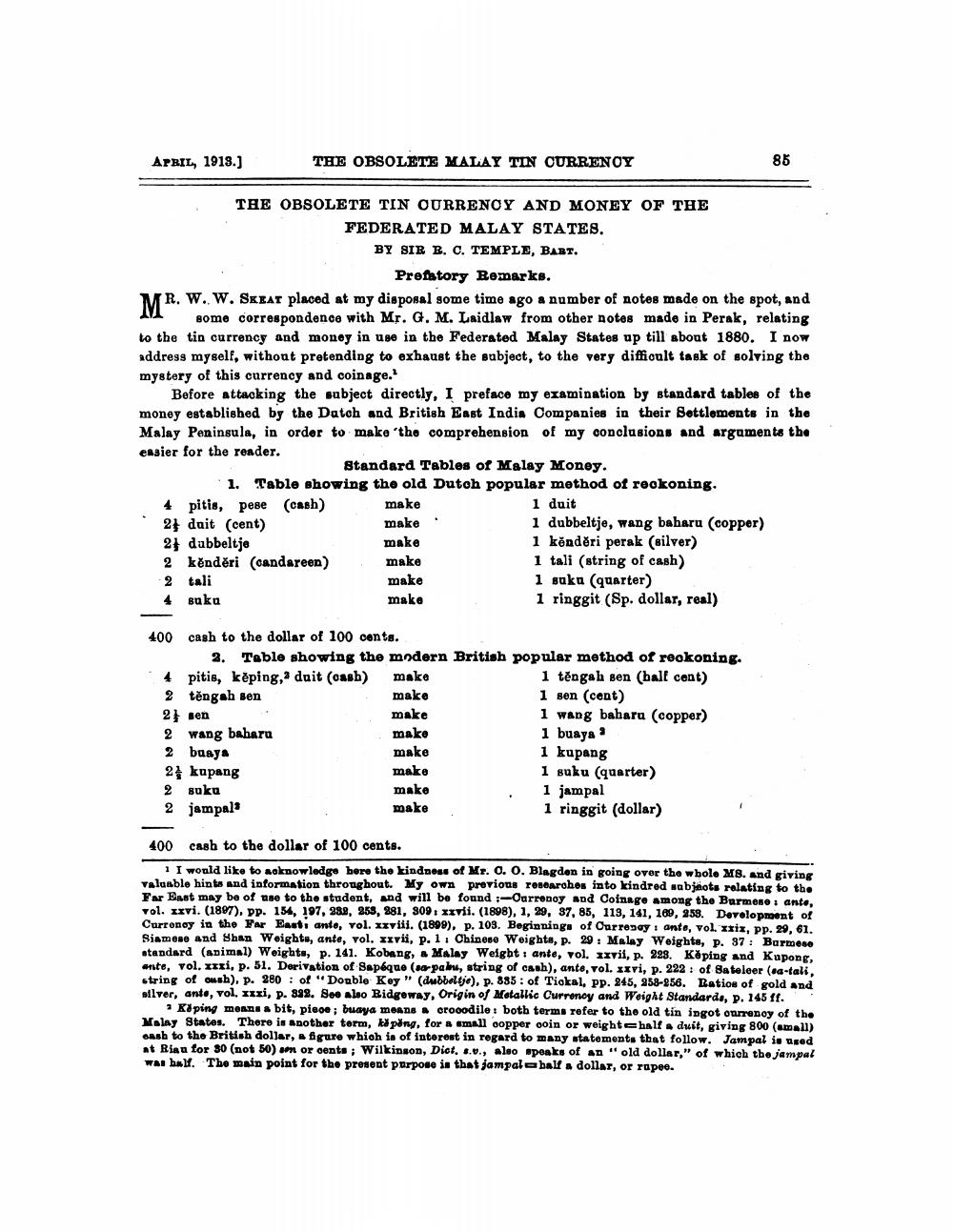________________
APRIL, 1918.)
THE OBSOLETE MALAY TIN CURRENOY
86
THE OBSOLETE TIN QURRENCY AND MONEY OF THE
FEDERATED MALAY STATES. BY SIR B. C. TEMPLE, BART.
Prefatory Bemarks. MR. W. W. SKEAT placed at my disposal some time ago a number of notes made on the spot, and
some correspondence with Mr. G. M. Laidlaw from other notes made in Perak, relating to the tin currency and money in use in the Federated Malay States up till about 1880. I now address myself, without pretending to exhaust the subject, to the very difficult task of solving the mystery of this currency and coinage."
Before attacking the subject directly, I preface my examination by standard tables of the money established by the Datoh and British East India Companies in their Bottlements in the Malay Peninsula, in order to make the comprehension of my conclusions and argaments the easier for the reader.
Standard Tables of Malay Money. 1. Table showing the old Dutch popular method of reckoning. 4 pitis, pese (cash) make
1 duit 2 dait (cent)
1 dubbeltje, wang baharu (copper) 2} dubbeltje
make
1 konděri perak (silver) 2 kenderi (candareen) make
1 tali (string of cash) 2 tali
make
1 suka (quarter) 4 Buka
make
1 ringgit (Sp. dollar, real)
make.
400 cash to the dollar of 100 conte.
2. Table showing the modern British popular method of rookoning. 4 pitis, kėping, duit (cash) make
1 tengah sen (half cent) 2 těngah sen
make
1 sen (cent) 2 sen
make
1 wang baharu (copper) 2 wang baharu
make
1 buaya 2 buaya
make
1 kupang 2 kupang
make
1 suku (quarter) 2 suku
make
1 jampal 2 jam pals
make
1 ringgit (dollar)
400 cash to the dollar of 100 cents.
I would like to acknowledge bere the kindness of Mr. O. O. Blagdan in going over the whole M8. and giving valuable hints and information throughout. My own previous researches into kindred sabjaots relating to the Frant may be of use to the student, and will be found :-Ourrenoy and Coinage among the Burmesos ante. vol. zxvi. (1897), pp. 154, 197, 389, 358, 881, 809. xxvii. (1898), 1, 29, 37, 85, 113, 141, 100, 258. Development of Currency in the Far Easti anto, vol. xxvii. (1899), p. 103. Beginnings of Currency : ante, vol. xxix, PP. 29, 61. Siamese and Shan Weighte, ante, vol. XXVII, p. 1. Chinese Weights, p. 29: Malay Weights, p. 87: Burmese atandard (animal) Weights, p. 141. Kobang, Malay Weight: ante, vol. xxvil, p. 328. Kěping and Kapong, ante, vol. xxxi, p. 51. Derivation of Sapéque (sar paine, string of cash), ante, vol. xxvi, p. 222: of sateleer (na-tali, string of oush), p. 280 : of "Double Koy" (dubbelto), p. 885 : of Tiokal, PP. 845, 958-856. Ratios of gold and silver, ante, vol. xxxi, p. 899. Soe aloo Ridgeway, Origin of Metallic Currenoy and Weight Standards, p. 145 11.
- Kiping means a bit, pione; buaya means crocodile: both terms refer to the old tin ingot ourrenoy of the Malay States. There is another torm, kpång, for a small copper coin or weight chall duit, giving 800 (small) cash to the British dollar, figure which is of interest in regard to many statements that follow. Jampal is used at Rian for 30 (not 50) sm or conta ; Wilkinson, Dict, 5.0., also speaks of an "old dollar, of which the jampal wa bal. The main point for the present purpose is that jampal obalf a dollar, or rapee.




